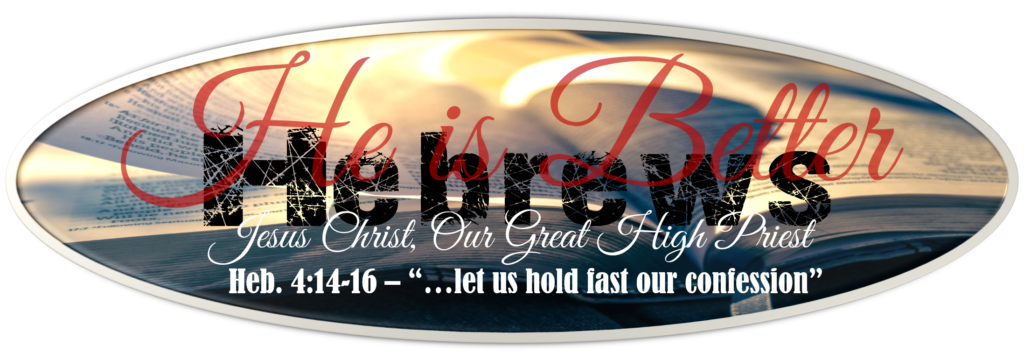
A More Excellent Ministry
We know that the final section of Hebrews (10:19-13:25) focuses on encouraging us in our faithful w![]() alk in Christ, and the section that we now look at will take us to the beginning of that material. We were told in Heb. 7:25-28 Christ introduced a “better covenant” (than Moses) which would provide salvation “to the uttermost”. This meant that it was appropriate for Christ, God’s Son, to be our High Priest, completely righteous and perfectly satisfactory to God for our redemption. In Rom. 8:33-34 we are told about Christ’s intercessory ministry for us now that He is seated at God’s right hand. Our confidence in Christ’s finished work on the Cross is the key to our faithfully living for Him. In Heb. 8, we learn much more of how Jesus provides our complete and final salvation.
alk in Christ, and the section that we now look at will take us to the beginning of that material. We were told in Heb. 7:25-28 Christ introduced a “better covenant” (than Moses) which would provide salvation “to the uttermost”. This meant that it was appropriate for Christ, God’s Son, to be our High Priest, completely righteous and perfectly satisfactory to God for our redemption. In Rom. 8:33-34 we are told about Christ’s intercessory ministry for us now that He is seated at God’s right hand. Our confidence in Christ’s finished work on the Cross is the key to our faithfully living for Him. In Heb. 8, we learn much more of how Jesus provides our complete and final salvation.
Hebrews 8:1 begins by the writer declaring “the main point”, He is now bringing his previous thoughts to a final point of conclusion. This core truth which he now moves to regarding the High Priestly work of Jesus Christ will prove to be his central message. He is moving towards final truth and application, so we need to remember what has been said in Heb. 1-7, all that God has spoken, the old Law is superseded by Christ (angels, Moses, Aaron), and how we need to be “faithful to our faith” (as expressed in the warning passages). Heb. 8-10 are the final exposition of truth related to Jesus Christ as our Great High Priest.
The flow of the writer’s theme of truths is now moved to conclusion in Heb. 8:1 through Heb. 10:18. In Heb. 8, we have a Better Covenant on which Christ’s priesthood is based, compared to the old Levitical priesthood based on the old Mosaic covenant. Then In Heb 9:1-10, we see the Better Sanctuary, and in Heb. 9:11-10:18, the Better Sacrifice. Note the three-fold declaration of Heb. 8:6: A more excellent ministry leads to > a Mediator of a Better Covenant whicih leads to > being Established on Better Promises. The writer now proceeds to elaborate on Christ’s excellent ministry. The writer frames this entire section of his letter (Heb. 8:1-10:18) as an exposition and elaboration of Jer. 31:31-34, which is the great New Covenant promise revealed by God. This covenant is offered to us in the Church Age by Christ but its final fulfillment will be under Millennial reign of Christ and into the eternal state.
 Hebrews 8:1-5, The Victor – Honored & At Rest
Hebrews 8:1-5, The Victor – Honored & At Rest
John 1 tells us that Jesus, God’s Son and promised Messiah, came to Earth as a man and “dwelled among us![]() ” (Jn. 1:14). From His birth to His death, He “humbled Himself” and endured the mud and dirt, sweat and fatigue of being a man, walking throughout Israel with His disciples for three years, ministering to thronging crowds and needy souls. He was faithful in His mission for His Father all the way to death on the Cross (Phil. 2:7-8). Now in Heb. 8:1-6, our Hebrews writer tells us that this same Lord Jesus Christ is “seated” in heaven at the right hand of the Father (Eph. 1:20), as prophesied in Psa. 110:1. Jesus Christ now ministers as our Great High Priest, and He has taken His place in the Holiest of Holies, the Inner Sanctuary of the heavenly Tabernacle.
” (Jn. 1:14). From His birth to His death, He “humbled Himself” and endured the mud and dirt, sweat and fatigue of being a man, walking throughout Israel with His disciples for three years, ministering to thronging crowds and needy souls. He was faithful in His mission for His Father all the way to death on the Cross (Phil. 2:7-8). Now in Heb. 8:1-6, our Hebrews writer tells us that this same Lord Jesus Christ is “seated” in heaven at the right hand of the Father (Eph. 1:20), as prophesied in Psa. 110:1. Jesus Christ now ministers as our Great High Priest, and He has taken His place in the Holiest of Holies, the Inner Sanctuary of the heavenly Tabernacle.
The important message of these verses (Heb. 8:1, “the main point” is that a final and completely effective sacrifice and atonement have now been accomplished through Jesus Christ. What was previously shown only as a “shadow” or “picture” (Col. 2:17) – repeated sacrifices for sin that provided temporary forgiveness – is now final and completed reality. God has progressed from promise to fulfillment. God had told Moses that the Tabernacle and its rituals were a shadow of the “real thing” (Exo. 25:9, 40), the heavenly sanctuary where God resides. Hebrews contains many references to the “old” practices of the Levitical priesthood (Heb. 7:27-28; 9:7-8, 25; 10:1-3, 8; 13:10-11), and shows how these things pointed to fulfillment in Christ. The OT sacrifices of the Tabernacle and Temple didn’t meet man’s need for a clear conscience and a personal relationship with God. They were temporary, administered by fallen men. Most importantly, they were a type, a shadow of the final reality of the Messiah’s sacrifice on the Cross.
A key truth is that we as NT believers have Jesus as our Great High Priest as a present possession. He is our Seated Savior functioning as our superior Great High Priest. In the Levitical system priests never sat, they were always executing the duties of their ministry (see for example Number 28). As Heb. 10:11-12 states, the human priest stood continuously ministering temporary sacrifices that never permanently removed our sin and penalty – in God’s plan, they served as a copy and shadow of the reality to come in Jesus Christ (Heb. 8:5). The Greek word for “copy” refers to something that is an imitation or representation of the real thing, an example for warning or alert. Note Heb. 9:9-10, a symbol for the present time until the “time of reformation”. Jesus offered one totally sufficient sacrifice – on the Cross, He was the One who stood between two parties as an arbitrator (see 1 Tim. 2:5; Gal 3:19-20); then He sat down as the Mediator of a better covenant. As elaborated in Jer. 31:31-34, Christ brought about the New Covenant (Heb. 8:8,13; 9:15).
Just as we know Jesus actually lived among men for 33 year, Jesus’ priesthoood is now a heavenly reality. His disciples were with Him when He ascended into heaven, when He began His ministry as King/Priest (Acts 1:1-11). He now resides in heaven as our eternal Savior and Intercessor (Heb. 7:23-28), ministering in the true, heavenly tabernacle of God’s presence (Heb. 9:11, 24). Christ is now superior in three ways (Constable): 1) He is a seated priest, His work is complete; 2) He is an enthroned priest, now seated at God’s right hand; 3) He is a heavenly priest residing in the heavenly sanctuary. He pleads our cause (Heb. 8:6; 9:15; 12:24). This reality continues to be developed through to Heb. 9:28, and it is clearly the central and most distinctive aspect of the writer’s interpretation of the saving work of Christ.
Heb. 8:6-13 – Better Covenant, Better Promises
Viewing Christ as seated at God’s Right Hand in the Heavenly Sanctuary, the writer now looks at the New Covenant relationship He guarantees for every believer for eternity. The Risen Savior will be shown demonstrating a permanent “more excellent ministry” in comparison to the human, temporal and temporary ministry God put in place with Moses. As the writer said in Heb. 7:25, Jesus now resides in heaven as our Intercessor, providing our salvation through all time and into eternity. This passage provides a triple expression of Christ’s superior position by His “more excellent ministry”, “better covenant”, and “better promises”. It is this “triple crown” the writer now speaks of, using the words and truths of the New Covenant which God reveals through Jeremiah. The writer states this cornerstone doctrinal truth in Heb. 8:7 & 13, then uses those verses as a framework to quote Jer. 31:31-34 to elaborate the truth.
In a very logical “if-then” statement (Heb. 8:7), he reminds us that if the first covenant (with Moses) had been faultless, it would have been able to provide full redemption, but it wasn’t, it did fall short. God intended the Mosaic Covenant to be temporary in contrast to the New Covenant. It was not God’s final provision, but it did point to fulfillment in Christ. God inspired Jeremiah to declare God’s plan for a New Covenant in Jer. 31:31-34, and the Hebrews writer chose to quote this passage at length in order to emphasize its importance in expressing God’s great plan of Redemption. He said “the days are coming!” (Heb. 8:8), refering to “days” of Restoration which would follow after the Day of the Lord and God’s final judgment of Satan and sin (as depicted in many prophetic Bible passages and the book of Revelation).
Heb. 8:6 tells us God has established the New Covenant on “better promises”. Eze. 36:26-27 emphasizes that the New Covenant is “of the heart” (compare also Psa. 68:18; 110:1; Zech. 8:8; Isa. 54:13; Eph. 1:20; Col. 3:1; Heb. 3:1; 10:12). Consider what “better promises” includes from these passages, and how these things are provided by the New Covenant as shared in Heb. 8:8-12. Feel free to add additional “better things” to this list.
-
- forgiveness of sin
- inner disposition to pursue holiness
- completed relationship with God
- ongoing knowledge of God
In Heb. 8:13 – God has, by His own hand, made the Old Covenant obsolete by establishing the New Covenant in Christ. Everything about it will disappear completely, it will never again impact man’s relationship with God. Note that God maintains the unconditional covenants (Abrahamic, Palestinian, Davidic, and New), all of which were further elaborations of the Abrahamic Covenant. The Mosaic Covenant was conditional, “added” (Gal. 3:15-29) deal with man in his fallen condition. In putting aside the conditional Old Covenant, the unconditional covenants remain in effect into eternity.
Bible Study Journal
- What does the word “such” in 8:1 refer back in ch. 7? What’s the point?
- In 8:2, why is Jesus’ ministry superior to the Levitical priest?
- What are the three things about Christ stated in v1 and why are they important?
- What does 8:3 say every priest does?
- According to 8:4, if Jesus were on earth, would He be our priest? Why?
- In ch 7-8, how was the first “old” covenant not perfect?
- What are the “better promises” God mentions in 8:10-12?
- In Hebrews, how does God use the word “covenant”?
- What actions do you think of when you hear that Christ is our Mediator?
- If 8:13 says the old covenant is obsolete, what does that mean about the Old Testament in the Bible?
- Look at Heb. 7:11-28 and write down ways how the old Mosaic covenant was limited.




